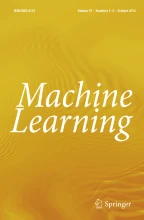Abstract
We study the problem of deterministically predicting boolean valuesby combining the boolean predictions of several experts.Previous on-line algorithms for this problem predict with the weightedmajority of the experts' predictions.These algorithms give each expert an exponential weight βmwhere β is a constant in [0,1) and m is the number of mistakesmade by the expert in the past. We show that it is better to usesums of binomials as weights.In particular, we present a deterministic algorithmusing binomial weights that has a better worst case mistake bound than thebest deterministic algorithm using exponential weights.The binomial weights naturally arise from a version space argument.We also show how both exponential and binomial weighting schemes can beused to make prediction algorithms robust against noise.
Article PDF
Similar content being viewed by others
Explore related subjects
Discover the latest articles, news and stories from top researchers in related subjects.Avoid common mistakes on your manuscript.
References
Aarts, E. & Korst, J. (1989). Simulated Annealing and Boltzmann Machines. John Wiley and Sons.
Alon, N., Spencer, J.H. & Erdös, P. (1992). The Probabilistic Method. John Wiley and Sons.
Angluin, D. (1988). Queries and concept learning. Machine Learning, 2:319–342.
Aslam, J.A. & Dhagat, A. (1991). Searching in the presence of linearly bounded errors. In Proceedings of the 23rd ACM Symposium on the Theory of Computation, pages 486–493. ACM Press.
Auer, P. & Long, P.M. (to appear). Structural results about on-line learning models with and without queries. Machine Learning.
Auer, P. & Long, P.M. (1994). Simulating access to hidden information while learning. In Proceedings of the 26th ACM Symposium on the Theory of Computation, pages 263–272. ACM Press.
Bardzin, J.M. & Freivalds, R.V. (1972). On the prediction of general recursive functions. Soviet Math.Dokl., 13:1224–1228.
Berlekamp, E.R. (1968). Error-Correcting Codes. John Wiley and Sons.
Cesa-Bianchi, N., Freund, Y., Helmbold, D.P., Haussler, D., Schapire, R. & Warmuth, M.K. (1995). How to use expert advice. To appear in Journal of the ACM.
Cesa-Bianchi, N., Long, P.M. & Warmuth, M.K. (1996). Worst-case quadratic loss bounds for a generalization of the Widrow-Hoff rule. IEEE Transactions on Neural Networks, 7(2): 604-619.
Chernoff, H. (1952). Ameasure of asymptotic efficiency for tests of a hypothesis based on the sum of observations. Annals of Mathematical Statistics, 23:493–507.
Graham, R.L., Knuth, D.E. & Patashnik, O. (1989). Concrete Mathematics. Addison Wesley.
Kivinen, J. & Warmuth, M.K. (1994). Using experts for predicting continuous outcomes. In Computational Learning Theory: Eurocolt’ 93.The Institute of Mathematics and its Applications Conference Series, number 53, pages 109-120, Oxford: Oxford University Press.
Littlestone, N. (1988). Learning quickly when irrelevant attributes abound: a new linear-threshold algorithm. Machine Learning, 2(4):285–318.
Littlestone, N. (1989). Mistake Bounds and Logarithmic Linear-threshold Learning Algorithms. PhD thesis, University of California at Santa Cruz.
Littlestone, N., Long, P.M. & Warmuth, M.K. (1995). On-line learning of linear functions. Computational Complexity, 5(1):1–23.
Littlestone, N. & Warmuth, M.K. (1994). The weighted majority algorithm. Information and Computation, 108:212–261.
Mitchell, T.M. (1977). Version spaces: A candidate elimination approach to rule learning. In Proceedings International Joint Conference on Artificial Intelligence, pages 305–310, Cambridge, Mass.
Spencer, J. (1992). Ulam's searching game with a fixed number of lies. Theoretical Computer Science, 95:307–321.
Ulam, S. (1977). Adventures of a Mathematician. Scribners.
Vovk, V.G. (1990). Aggregating strategies. In Proceedings of the 3rd Annual Workshop on Computational Learning Theory, pages 372–383.
Author information
Authors and Affiliations
Rights and permissions
About this article
Cite this article
Cesa-Bianchi, N., Freund, Y., Helmbold, D.P. et al. On-line Prediction and Conversion Strategies. Machine Learning 25, 71–110 (1996). https://doi.org/10.1023/A:1018348209754
Issue Date:
DOI: https://doi.org/10.1023/A:1018348209754
